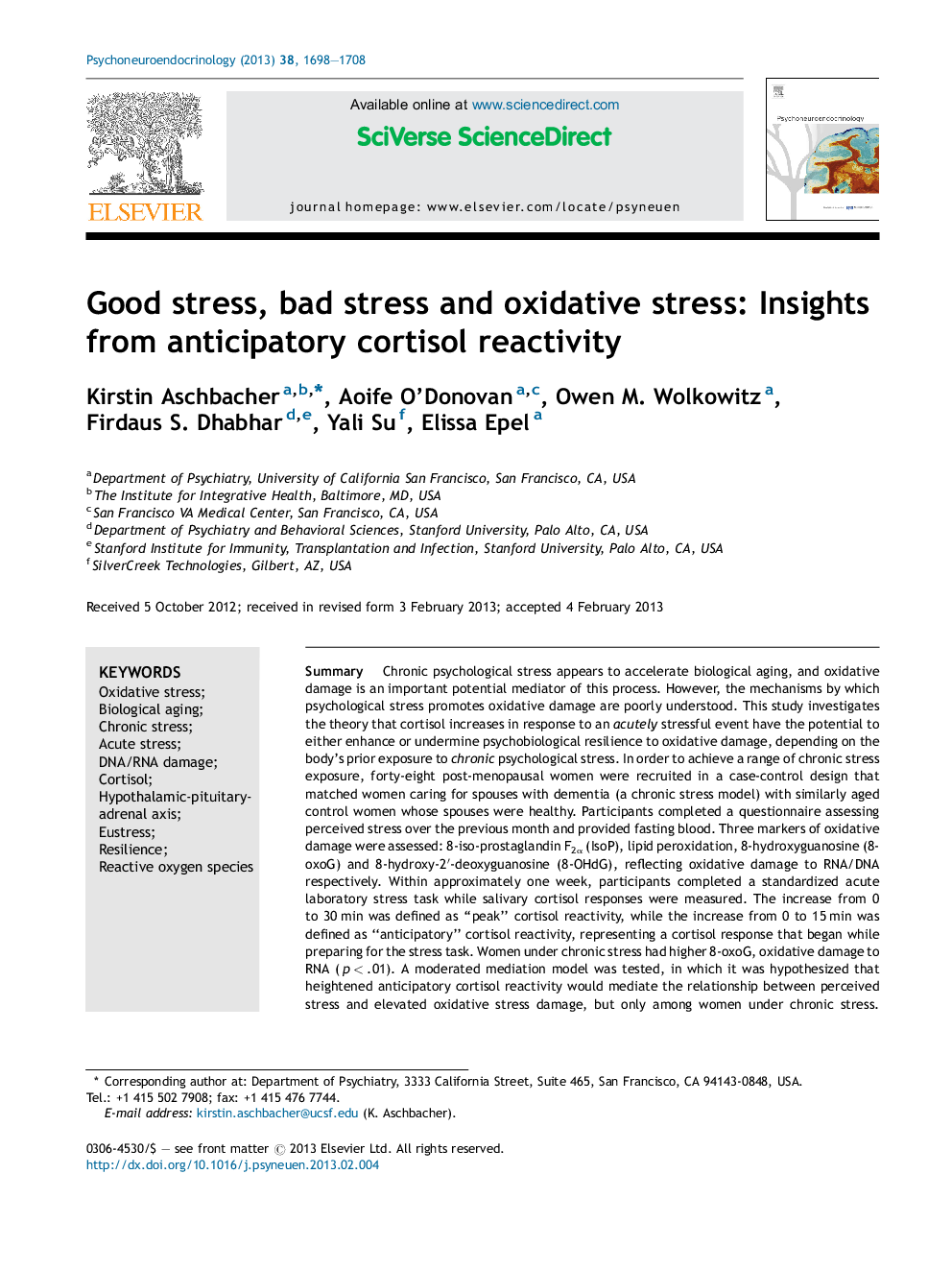| کد مقاله | کد نشریه | سال انتشار | مقاله انگلیسی | نسخه تمام متن |
|---|---|---|---|---|
| 10306081 | 547123 | 2013 | 11 صفحه PDF | دانلود رایگان |
عنوان انگلیسی مقاله ISI
Good stress, bad stress and oxidative stress: Insights from anticipatory cortisol reactivity
ترجمه فارسی عنوان
استرس خوب، استرس بد و استرس اکسیداتیو: بینش از واکنش پذیری پیشگیرانه کورتیزول
دانلود مقاله + سفارش ترجمه
دانلود مقاله ISI انگلیسی
رایگان برای ایرانیان
کلمات کلیدی
موضوعات مرتبط
علوم زیستی و بیوفناوری
بیوشیمی، ژنتیک و زیست شناسی مولکولی
علوم غدد
چکیده انگلیسی
Chronic psychological stress appears to accelerate biological aging, and oxidative damage is an important potential mediator of this process. However, the mechanisms by which psychological stress promotes oxidative damage are poorly understood. This study investigates the theory that cortisol increases in response to an acutely stressful event have the potential to either enhance or undermine psychobiological resilience to oxidative damage, depending on the body's prior exposure to chronic psychological stress. In order to achieve a range of chronic stress exposure, forty-eight post-menopausal women were recruited in a case-control design that matched women caring for spouses with dementia (a chronic stress model) with similarly aged control women whose spouses were healthy. Participants completed a questionnaire assessing perceived stress over the previous month and provided fasting blood. Three markers of oxidative damage were assessed: 8-iso-prostaglandin F2α (IsoP), lipid peroxidation, 8-hydroxyguanosine (8-oxoG) and 8-hydroxy-2â²-deoxyguanosine (8-OHdG), reflecting oxidative damage to RNA/DNA respectively. Within approximately one week, participants completed a standardized acute laboratory stress task while salivary cortisol responses were measured. The increase from 0 to 30 min was defined as “peak” cortisol reactivity, while the increase from 0 to 15 min was defined as “anticipatory” cortisol reactivity, representing a cortisol response that began while preparing for the stress task. Women under chronic stress had higher 8-oxoG, oxidative damage to RNA (p < .01). A moderated mediation model was tested, in which it was hypothesized that heightened anticipatory cortisol reactivity would mediate the relationship between perceived stress and elevated oxidative stress damage, but only among women under chronic stress. Consistent with this model, bootstrapped path analysis found significant indirect paths from perceived stress to 8-oxoG and IsoP (but not 8-OHdG) via anticipatory cortisol reactivity, showing the expected relations among chronically stressed participants (p â¤Â .01) Intriguingly, among those with low chronic stress exposure, moderate (compared to low) levels of perceived stress were associated with reduced levels of oxidative damage. Hence, this study supports the emerging model that chronic stress exposure promotes oxidative damage through frequent and sustained activation of the hypothalamic-pituitary-adrenal axis. It also supports the less studied model of 'eustress' - that manageable levels of life stress may enhance psychobiological resilience to oxidative damage.
ناشر
Database: Elsevier - ScienceDirect (ساینس دایرکت)
Journal: Psychoneuroendocrinology - Volume 38, Issue 9, September 2013, Pages 1698-1708
Journal: Psychoneuroendocrinology - Volume 38, Issue 9, September 2013, Pages 1698-1708
نویسندگان
Kirstin Aschbacher, Aoife O'Donovan, Owen M. Wolkowitz, Firdaus S. Dhabhar, Yali Su, Elissa Epel,
